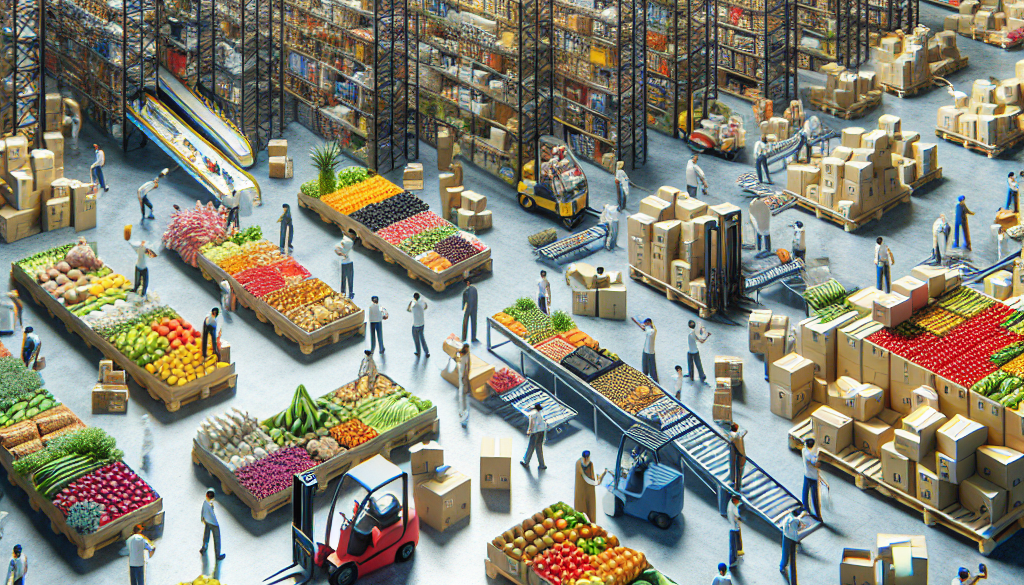Navigating the Challenges of Food Distribution
-
Table of Contents
- Food Distribution Challenges: Strategies for Efficient Management
- Understanding the Food Distribution Network
- Key Challenges in Food Distribution
- Perishability of Products
- Supply Chain Complexities
- Regulatory Compliance
- Environmental Concerns
- Technological Integration
- Strategies for Overcoming Distribution Challenges
- Investing in Cold Chain Infrastructure
- Streamlining Supply Chain Operations
- Ensuring Regulatory Compliance
- Embracing Sustainability
- Leveraging Technology
- Conclusion: Ensuring a Resilient Food Distribution Network
- Enhance Your Food Products with ETprotein’s High-Quality Proteins
Food Distribution Challenges: Strategies for Efficient Management

The global food distribution network is a complex and vital system that ensures the availability of food products to consumers worldwide. However, navigating the challenges of food distribution requires a deep understanding of the intricacies involved in moving food from producers to consumers. This article explores the hurdles faced by the food distribution industry and offers insights into overcoming these obstacles.
Understanding the Food Distribution Network
Food distribution involves a series of steps that include processing, packaging, transportation, storage, and retailing. Each step is crucial in maintaining the quality and safety of food products. The network is not only about moving goods but also about managing information, finances, and relationships across the supply chain.
Key Challenges in Food Distribution
The food distribution sector faces several challenges that can impact efficiency and effectiveness:
- Perishability of Products
- Supply Chain Complexities
- Regulatory Compliance
- Environmental Concerns
- Technological Integration
Perishability of Products
One of the primary challenges in food distribution is the perishable nature of many food items. Fresh produce, dairy, and meat products require careful handling and a cold chain logistics system to maintain freshness and prevent spoilage.
Supply Chain Complexities
The food supply chain is often global, with many intermediaries. This complexity can lead to inefficiencies and increased chances of disruption due to factors like political instability, natural disasters, or pandemics.
Regulatory Compliance
Food distributors must adhere to a myriad of regulations that vary by country and region. These regulations are in place to ensure food safety but can create logistical and administrative challenges.
Environmental Concerns
Food distribution is a significant contributor to carbon emissions, and there is increasing pressure to adopt more sustainable practices. This includes reducing food waste, optimizing transportation routes, and using eco-friendly packaging.
Technological Integration
Adopting new technologies can be costly and complex, but it is essential for modernizing the food distribution process. Technologies like blockchain, IoT, and AI can improve traceability, efficiency, and decision-making.
Strategies for Overcoming Distribution Challenges
To navigate these challenges, food distributors can implement several strategies:
- Investing in Cold Chain Infrastructure
- Streamlining Supply Chain Operations
- Ensuring Regulatory Compliance
- Embracing Sustainability
- Leveraging Technology
Investing in Cold Chain Infrastructure
Building a robust cold chain infrastructure is essential for maintaining the quality of perishable goods. This includes refrigerated transportation, warehousing, and real-time temperature monitoring systems.
Streamlining Supply Chain Operations
By simplifying the supply chain, distributors can reduce costs and improve efficiency. This might involve consolidating shipments, optimizing routes, or partnering with local producers.
Ensuring Regulatory Compliance
Staying up-to-date with food safety regulations and investing in compliance can prevent costly recalls and protect consumer health.
Embracing Sustainability
Implementing sustainable practices not only benefits the environment but can also lead to cost savings and improved brand reputation. This includes reducing food waste, using renewable energy sources, and adopting biodegradable packaging.
Leveraging Technology
Technology can provide solutions to many of the challenges faced by food distributors. For example, blockchain can enhance traceability, while AI can optimize inventory management and demand forecasting.
Conclusion: Ensuring a Resilient Food Distribution Network
Navigating the challenges of food distribution requires a multifaceted approach that addresses the unique needs of the industry. By investing in infrastructure, streamlining operations, complying with regulations, embracing sustainability, and leveraging technology, food distributors can create a more resilient and efficient network. The key takeaways for managing food distribution challenges include understanding the complexities of the supply chain, being proactive in regulatory compliance, and adopting innovative solutions to stay ahead of the curve.
Enhance Your Food Products with ETprotein’s High-Quality Proteins
In the context of food distribution, the quality of ingredients is paramount. ETprotein offers a range of high-quality protein products that can enhance the nutritional value of food and beverage offerings. Their organic, non-GMO, allergen-free proteins are ideal for a variety of applications, from sports nutrition to health and wellness products. By incorporating ETprotein’s proteins into your food products, you can ensure that your offerings meet the highest standards of quality and nutrition.
About ETprotein:
ETprotein, a reputable protein and L-(+)-Ergothioneine (EGT) Chinese factory manufacturer and supplier, is renowned for producing, stocking, exporting, and delivering the highest quality organic bulk vegan proteins and L-(+)-Ergothioneine. They include Organic rice protein, clear rice protein, pea protein, clear pea protein, watermelon seed protein, pumpkin seed protein, sunflower seed protein, mung bean protein, peanut protein, and L-(+)-Ergothioneine EGT Pharmaceutical grade, L-(+)-Ergothioneine EGT food grade, L-(+)-Ergothioneine EGT cosmetic grade, L-(+)-Ergothioneine EGT reference grade and L-(+)-Ergothioneine EGT standard. Their offerings, characterized by a neutral taste, non-GMO, allergen-free attributes, with L-(+)-Ergothioneine purity over 98%, 99%, cater to a diverse range of industries. They serve nutraceutical, pharmaceutical, cosmeceutical, veterinary, as well as food and beverage finished product distributors, traders, and manufacturers across Europe, USA, Canada, Australia, Thailand, Japan, Korea, Brazil, and Chile, among others.
ETprotein specialization includes exporting and delivering tailor-made protein powder and finished nutritional supplements. Their extensive product range covers sectors like Food and Beverage, Sports Nutrition, Weight Management, Dietary Supplements, Health and Wellness Products, and Infant Formula, ensuring comprehensive solutions to meet all your protein needs.
As a trusted company by leading global food and beverage brands and Fortune 500 companies, ETprotein reinforces China’s reputation in the global arena. For more information or to sample their products, please contact them and email sales(at)ETprotein.com today.












